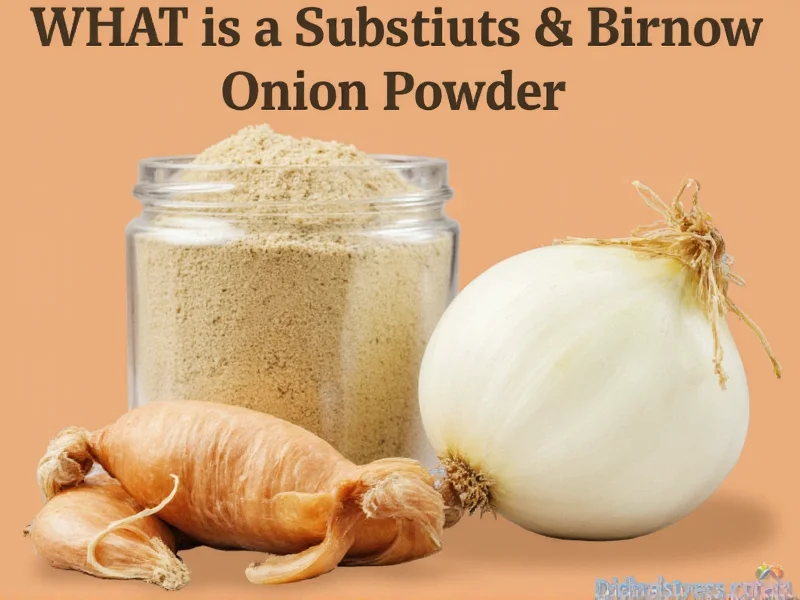If you're in the middle of cooking and just realized you're out of onion powder, don't panic. Many common kitchen ingredients can effectively replace this popular seasoning while maintaining the savory depth your recipe requires. Understanding your substitution options ensures your dish still delivers that essential umami flavor without compromising texture or balance.
Top Onion Powder Substitutes Explained
Onion powder provides concentrated onion flavor without moisture, making it ideal for spice rubs, dry mixes, and long-cooking dishes. When substituting, consider both flavor intensity and moisture content to prevent recipe failure. Here's a detailed breakdown of your best options:
Fresh Onions: The Most Accessible Alternative
Yellow onions offer the closest flavor profile to onion powder. For every teaspoon of onion powder required, use 1/4 cup finely minced raw onion. When cooking with fresh onions:
- For baked goods or dry rubs: Sauté onions first to remove excess moisture
- In soups/stews: Add raw onions early in cooking to allow flavors to meld
- For immediate use: Pat minced onions dry with paper towels
Onion Salt: The Quick Pantry Swap
Onion salt combines ground onion with salt (typically 3:1 ratio). Substitute 3/4 teaspoon onion salt for every 1 teaspoon onion powder, then reduce additional salt in your recipe by 1/4 teaspoon. This works particularly well for:
- Meat rubs and seasoning blends
- Salad dressings and marinades
- Instant pot or pressure cooker recipes
Shallots: The Gourmet Option
With a more delicate, slightly sweet flavor, shallots make an excellent substitute when you want subtle onion notes. Use 2 tablespoons minced shallot per teaspoon of onion powder. Ideal for:
- Creamy sauces and delicate soups
- Fish and poultry dishes
- Vinaigrettes and light dressings
Garlic Powder: The Flavorful Compromise
While not identical, garlic powder provides similar umami depth at half the quantity (use 1/2 tsp garlic powder per 1 tsp onion powder). Best reserved for:
- Meatloaf and burger mixes
- Tomato-based sauces
- Savory baked goods like cheese biscuits
| Substitute | Conversion Ratio | Best For | Moisture Consideration |
|---|---|---|---|
| Fresh Yellow Onion | 1/4 cup minced = 1 tsp powder | Stews, casseroles, soups | Sauté first for dry applications |
| Onion Salt | 3/4 tsp = 1 tsp powder | Rubs, dressings, quick breads | No moisture adjustment needed |
| Shallots | 2 tbsp minced = 1 tsp powder | Cream sauces, fish, light dishes | Pat dry before use |
| Garlic Powder | 1/2 tsp = 1 tsp powder | Meat dishes, tomato sauces | Dry ingredient - no adjustment |
| Onion Flakes | 1 tbsp = 1 tsp powder | Slow cooker recipes | Rehydrate with 1 tsp water |
Choosing the Right Substitute for Your Recipe
The ideal onion powder replacement depends on your specific dish. Consider these factors when making your substitution:
Moisture Content Matters
Dry applications like spice rubs or biscuit dough require moisture-free substitutes. Onion salt or garlic powder work best here. For wet dishes like chili or stew, fresh onions add welcome texture and flavor depth.
Flavor Intensity Balance
Stronger dishes like beef stew can handle potent substitutes like fresh onions, while delicate recipes like mashed potatoes benefit from milder shallots. When substituting in baking, remember that fresh onions may alter dough consistency.
Dietary Considerations
For low-sodium diets, avoid onion salt and opt for fresh onions or homemade onion powder. Those with onion sensitivities might use asafoetida (hing) at 1/8 teaspoon per teaspoon of onion powder, though this creates a distinctly different flavor profile.
Creating Your Own Onion Powder Substitute
When you need onion powder immediately and have fresh onions available, create a quick substitute by:
- Finely mince 1/2 cup yellow onion
- Microwave on low for 2-3 minutes until dry but not browned
- Cool completely before using
- Use 2 tablespoons of this dried minced onion per teaspoon of powder
This method preserves more flavor than store-bought powder while eliminating excess moisture. Store any leftovers in an airtight container for up to two weeks.
Common Substitution Mistakes to Avoid
Many home cooks make these critical errors when replacing onion powder:
- Using raw onions in dry applications without removing moisture
- Not adjusting salt when using onion salt
- Substituting equal volumes of fresh onion for powder (creates soggy dishes)
- Using onion powder substitutes in raw applications like salads
Remember that 1 cup of fresh onion equals approximately 3 tablespoons of onion powder after cooking out moisture - a crucial ratio for recipe success.
Specialty Recipe Considerations
Certain dishes require tailored substitution approaches:
For Baking
In biscuits, scones, or savory breads, use onion salt to maintain dry ingredient ratios. Reduce additional salt by 25% to compensate for the salt content in the substitute.
For Meat Rubs
Combine equal parts garlic powder and dried minced onion for a balanced flavor profile that adheres well to meat surfaces without creating paste.
For Soup and Sauce Bases
Fresh onions added at the beginning of cooking provide superior flavor development compared to powder. Sauté with carrots and celery for maximum flavor extraction.











 浙公网安备
33010002000092号
浙公网安备
33010002000092号 浙B2-20120091-4
浙B2-20120091-4